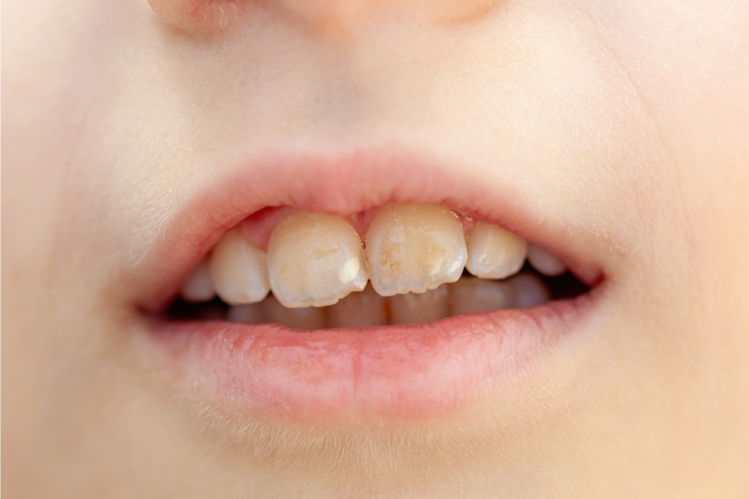
Table of Contents
- What Are White Spots on Teeth?
- Causes of White Spots on Teeth
- Are They Dangerous?
- How to Remove White Spots Naturally
- Cosmetic Treatment for White Spots
- Teeth Whitening
- Resin Infiltration
- White Spots After Braces
- White Spots: Prevention Tips
- Treatment Costs in Australia
- Fixing White Spots on Teeth
- FAQS
Have you ever glanced in the mirror, smiled, and seen tiny white spots on your teeth that just don't seem to go away? They are small for sure, but they can steal attention in the worst way. If your teeth are straight, it's fine, but those cloudy spots will still make you feel self-conscious.
The good thing is that white spots on teeth are fairly common, and they are treatable. And first, you want to figure out what is causing the white spots in the first place.
What Are White Spots on Teeth?
White spots are lighter, opaque regions found on the surface of the tooth due to changes in the enamel. In the vast majority of cases, white spots are the result of enamel demineralization, a form of loss of minerals like calcium from the enamel, leaving it slightly weaker.
White spots may be harmless, but they can indicate underlying concerns such as early stages of decay. White spots may develop on teeth as a result of natural causes, braces, or unrelated factors associated with the person’s childhood, such as excess fluoride.
Causes of White Spots on Teeth

Knowing the causes of white spots on teeth can help you prevent them in the future. Here are the most common ones:
Enamel Demineralization
When plaque isn’t removed properly, acids slowly erode enamel. This often happens around braces brackets, leaving chalky white patches once the braces are removed.
Fluorosis Marks
Too much fluoride while teeth are developing can cause fluorosis marks, bright white or slightly brownish spots. Kids who swallow toothpaste or drink water with high fluoride levels are more at risk.
Poor Nutrition
Lack of calcium, vitamin D, or other minerals can affect how enamel forms, leading to uneven colour and texture.
Dry Mouth
Saliva protects teeth by washing away bacteria. If you experience dry mouth due to medication or dehydration, your enamel becomes more susceptible to white spots.
Early Tooth Decay
Sometimes, these white marks are the very first sign of a cavity forming. Acting early can prevent the decay from spreading.
Are They Dangerous?
Most of the time, they’re cosmetic. But if linked to enamel demineralization or early decay, ignoring them can lead to cavities. Think of them as a warning sign rather than just a beauty concern.
How to Remove White Spots Naturally
Some people prefer starting with gentle, at-home approaches. These work best for early or mild spots:
- Remineralizing toothpaste: Fluoride or hydroxyapatite-containing products can support enamel strength and diminish surface stains.
- Nutritious diet: Products rich in calcium and vitamin D, like dairy and leafy greens, can bolster enamel.
- Hydration: Water and sugarless gum can help boost saliva production, which is especially important with a dry mouth.
- Oil pulling: Although not scientifically backed, the practice of swishing coconut oil could help eliminate bacteria and improve oral health.
Natural fixes are great for prevention or mild spots, but deeper marks often need professional care.
Cosmetic Treatment for White Spots
| Treatment | Best For | Longevity |
|---|---|---|
| Microabrasion | Shallow, surface-level spots | Permanent |
| Teeth Whitening | Mild spots + overall discolouration | 6-12 months |
| Resin Infiltration | Spots from demineralization | Permanent |
| Dental Bonding for White Marks | Deeper, stubborn spots | 5-10 years |
| Veneers | Severe, widespread marks | 10-15 years |
Modern dentistry offers several ways to restore a smooth, even smile. Here are the most effective cosmetic treatments for white spots:
Teeth Whitening
At Smilepath, we know how important a bright, confident smile is. That’s why we offer professional teeth whitening kits designed to safely and effectively remove stains and discolouration. A whiter smile not only boosts your confidence but also enhances your overall appearance.
With Smilepath, achieving a radiant, white smile is simple, safe, and affordable. Get ready to shine with a smile you’ll love to show off!
Resin Infiltration
A minimally invasive treatment that fills the porous white area with clear resin. It’s especially popular for spots caused by enamel demineralization after braces.
Dental Bonding for White Marks
For more noticeable spots, dental bonding for white marks delivers instant results. Your dentist applies a tooth-coloured resin over the affected area, blending it with the surrounding enamel.
Veneers
If you have widespread spots or other cosmetic concerns, veneers provide a long-term, flawless solution by completely covering the tooth surface.
White Spots After Braces
Many people notice white spots once braces come off. This happens when plaque builds up around brackets during treatment. The fix? Resin infiltration or microabrasion often works wonders to restore your smile.
White Spots: Prevention Tips
A few simple habits can keep white spots from showing up in the first place:
- Brush twice daily with remineralizing toothpaste.
- Floss every day to remove plaque between teeth.
- Avoid too many sugary, acidic foods and drinks.
- Make sure kids use the right amount of fluoride toothpaste.
- Stay hydrated to prevent dry mouth.
- Visit your dentist regularly for early detection.
Treatment Costs in Australia
| Approach | Cost Range (AUD) |
|---|---|
| At-Home Whitening (Smilepath) | $35.99 |
| Resin Infiltration | Starts from $650 |
| Bonding | $350-$500 per tooth |
| Porcelain Veneers | $2,500 per tooth |
Fixing White Spots on Teeth
The white spots that appeared on your teeth may be small, but they really can change your comfort level with your smile. Whether you choose to try home solutions or even have treatments like dental bonding to address the white spots, you don’t have to hide your teeth anymore. At Smilepath, we believe all Australians should have a smile they’re proud of because when someone loves their smile, they shine a little brighter each day.
FAQs
Use remineralising toothpaste, maintain good oral hygiene, and avoid acidic foods. For stubborn spots, professional treatments like whitening or resin infiltration work best.
Resin infiltration, dental bonding for white marks, microabrasion, or veneers are the most effective treatments, depending on the severity.
Citations:
Crna, R. N. M. (2025, March 11). Tips to treat white spots on teeth. https://www.medicalnewstoday.com/articles/322112
Website, N. (2025l, August 28). Teeth whitening. nhs.uk. https://www.nhs.uk/tests-and-treatments/teeth-whitening/







 Australia
Australia New Zealand
New Zealand Malaysia
Malaysia English
English Portuguese
Portuguese English
English English
English English
English English
English English
English Canada
Canada